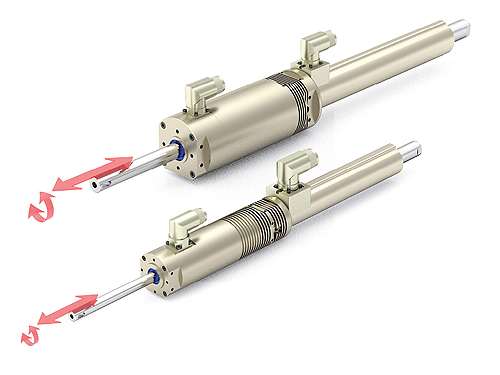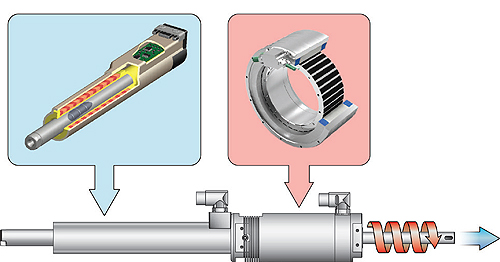by Ernst Blumer, LinMot & MagSpring
Linear-rotary motors provide users with greater on-the-fly process flexibility.
Linear-rotary motions are required in many machine applications, such as carton closing or handling and pick-and-place systems. For the first time, LinMot, a manufacturer of linear motor systems, has combined a linear motor with a servomotor in a compact unit that has significant advantages over the purely mechanical, pneumatic or partially electric drive solutions available to date.

For complex tasks such as threading, closing, pick and place, stacking, or aligning, designers must provide a linear-rotary motion. One example of this is a PET bottle closing machine. The closure cap on the cover must be placed on the bottle using a linear motion along the longitudinal axis and then screwed onto the threads of the bottle opening with an additional rotary motion until a defined angle or a certain torque has been reached. The solution to this task was one of two approaches for concentric closing machines.
1. Both the linear stroke and the rotation of the closing spindles are derived and synchronized purely mechanically from the rotary motion of the carousel using cam disks (linear stroke) and gears with a magnetic clutch (rotation).
2. A servomotor is used for the rotation and is moved up and down. The linear stroke is derived from the motion of the tabletop using plate cams, just as in the purely mechanical concept. This type of closing machine is frequently also called a servo-closer.
These approaches, however, have their own problems. One of the great drawbacks of the purely mechanical solution is that it lacks flexibility in the selection of the process variables, such as the tightening torque and press force. The torque, critical to the screwing process, can be adjusted and modified only by means of the magnetic clutch or hysteresis clutch on the spindle. The process parameters cannot be influenced during operation. The limited stroke is also a disadvantage in many applications. In practice, with this drive concept, often only 80 to 150 mm can be achieved, because larger strokes would slow down the closing process too much. It is also problematic that the machine operator cannot extract any information about the wear process from the drive system. Therefore, additional separate sensors may need to be installed and analyzed for process monitoring. In addition, the wear process for the purely mechanical concept depends on the speed of the carousel, due to the direct mechanical clutch. This can degrade process stability, especially when starting and stopping the system.

In more modern machines, a servomotor on each spindle provides the necessary rotation. But this can only solve part of the problems with the purely mechanical solution. The torque can indeed be adjusted electrically, and modified while running. The actual torque applied can also be determined by analyzing the drive data.
But these advantages come with a new disadvantage: Because the servomotors generally have to be moved along with the closing head, expensive flexible cables are required that can be used in a cable guide chain. These complicate the design, make it more difficult to clean and degrade the overall reliability of the machine. The stroke and press force still cannot be adjusted electrically, and the maximum stroke that can be achieved remains relatively small at 100 to 150 mm. Errors, such as crooked caps, can still be detected only by expensive downstream inspection systems.
Only the comprehensive use of electric drives for both the linear and the rotary motion can help here.
Users can then flexibly adapt not only the torque and the number of turns, but also the stroke, to the process requirements—even during the closing process, if necessary. The machine operator also has complete flexibility when it comes to the press force. It is possible, for example, to change the type of closure (turning to torque, turning to angle, pressing, hammering) at the push of a button. Linear units can also be used for larger strokes without a problem, so that even closing machines for large-volume bottles or aerosols with pump or spray closures, where the long suction tube must be inserted vertically together with the cap, can be implemented using the same drive concept.
Linear and rotary motions are thus decoupled from both the carousel motion and from each other, and can be programmed freely. This can ensure consistent process quality in all operating modes of a machine. In addition, critical process parameters, such as the tightening torque, the press force, and the position (such as the vertical cap position), can be derived directly from the data in the drive system and used again for documentation purposes as well as a control variable. Adjustments that have been tested once can be saved and called up using recipes. This means that machine operators can change formats more quickly. The electric system also does not require any moving cables.

Because of these advantages, some machine builders have switched to purely electric solutions. Lacking a standard solution, they were previously left to do their own design, with all the associated disadvantages.
LinMot took up this problem and developed the PR01 family of linear-rotary motors for applications such as handling and pick-and-place tasks, as well as for closing boxes and aligning printer marks.
The motors in this family provide forces up to 1024 N, a peak torque of 7.5 Nm and speeds up to 2,000 rpm. The particularly compact and lean motors can also perform strokes up to 300 mm. There are currently two sizes available, which differ in the maximum available torques for the rotary motors and the linear forces for the linear motors. In addition, variants are available with axial through-holes for passing through a mechanical cap ejector, or for supplying pneumatic grippers on the closing head.
The company offers an extensive line of accessories for the PR01 family of linear-rotary motors. They include strippers, cooling flanges, cooling fans for the rotary motor, a multifunctional flange, and a pneumatic brake and magnetic spring (MagSpring). Appropriate drives for actuating the motors are available—including modular drives for use near the machine that can be mounted directly on the carousel of a closing machine. The complete package is rounded out for the integrator with the LinMot-Talk software for configuring the drives.
LinMot
www.Linmot-usa.com


Leave a Reply
You must be logged in to post a comment.